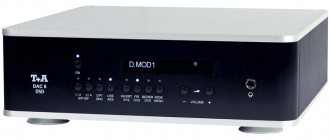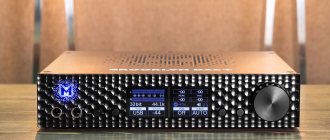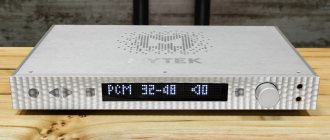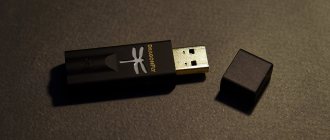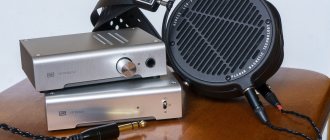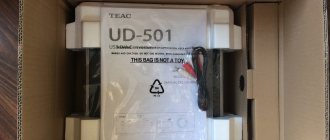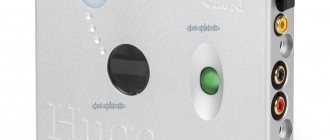Perhaps the use of a superlative suffix in the name was the only option for Chord to name the next model after the magnificent 2Qute. However, by declaring its latest and most affordable DAC to be "the most advanced in the world", the company has set the bar so high for the Qutest that failing to meet it would be a major disappointment.
Save and read later -
However, this DAC can serve as a model of composure and confidence. After all, Qutest is based on the Hugo 2, which received top marks at last year's Awards.
It uses the same DAC architecture, software and frequency filters as the Hugo 2, but the main difference is the absence of a headphone amplifier and the lithium-ion battery that ensures the portability of the Hugo.
The Qutest's sole purpose - to act as a bridge between a digital source and an amplifier - makes it similar to its predecessor, the 2Qute, which it replaced in the Chord line of five models.
The lack of equipment explains the price reduction to 131,740 rubles. (compared to 165,000 rubles for the Hugo 2) - although the word “disadvantage” only makes sense within the framework of this comparison. The Qutest suffers no more from a decline in functionality and performance than a top-of-the-line Swiss Army knife.
Out of sight
It took several days of warming up to get rid of the initial harshness of the midrange. We then removed the Chord 2Qute from the path between the reference Naim NDS/555 PS network player and the Gamut D3i preamp and placed the Qutest in its place. With Gregory Porter's Holding On, the improvement in clarity, precision and sophistication is so evident that we've quietly moved the Qutest's predecessor away.
However, the character of the sound has not changed. In 2015, we celebrated 2Qute's "unwavering coherence and musicality in any genre," and these qualities have remained intact.
A music scene filled with precise, clean, crisp and, of course, exceptionally detailed instrumentation fills the space between the ATC SCM50 speakers. The singer's rich, deep voice is equal parts visceral and dramatic, aided by the familiar neutral balance of the Chord DAC.
However, the detail of Qutest is noticeably higher. The increase in texture and nuance is most noticeable in the sound of the cymbals, double bass and Porter's syrupy, honeyed vocals; all images have enough space on the spacious Qutest canvas. The sound has become larger and more voluminous, which gives the components of the music the opportunity to unfold without infringing on each other.
Maturity of dynamics
Eyes Closed And Traveling by Peter Broderick highlights the increased dynamic maturity of our system. This piano composition demonstrates the artist's ability to move from tenderness to crushing pressure in a couple of moments, and Qutest conscientiously conveys its changing dynamics, tracking both powerful changes and subtle nuances.
The front edges of notes became clearer, the rear edges became more pronounced, and the notes themselves became warmer and more textured.
Increased rhythmicity allows the Qutest to easily handle the most complex structures. In Biffy Clyro's "My Recovery Injection," he accurately recreates not only the harsh dissonances of the lead guitar, but also its interaction with the imposing bassline and searing cymbals.
His rhythmic talents become even more evident in Spoon's Pink Up. The impressive drive that we have always admired from 2Qute, emphasizing the tempo changes, also saturates this psychedelic composition with a disco flavor.
From the soundstage-filling shakers to the xylophone melodic line and jagged vocals, all components are strictly subordinated to the overall metrical pulsation. Qutest is equally at home with powerful rock and sophisticated classics.
Full control
The improvement in sound quality is not surprising given that the Qutest uses proprietary field-programmable gate array (FPGA) digital-to-analog conversion technology, like all other Chord DACs.
Unlike most competitors that use off-the-shelf DAC chips, the company develops its own. By creating a more complex and highly customizable digital circuit, Chord provides complete control over everything from conversion to filtering.
The Qutest software is similar to the Hugo 2 software, providing "identical" levels of jitter reduction and "no" measurable modulation of noise floor (residual noise resulting from changes in the music signal).
The four filters remain the same; They don't change the sound of the music dramatically, but they're worth experimenting with. To select the desired option from the list of “neutral sharpness”, “neutral sharpness with HF smoothing”, “warm sound” and “warm sound with HF smoothing”, rotate the ball, which will change color depending on the filter.
The second ball glows different colors depending on the input. White represents the USB Type B port (accepting up to 32-bit/768 kHz PCM and DSD512 formats), yellow represents the first BNC coaxial input, red represents the second (24-bit/384 kHz), and green represents the optical (24-bit/192 kHz / DSD64).
Chord Electronics 2Qute DAC
Compact high-resolution DAC of the Chordette series. The circuit design is based on an FPGA and replicates the digital part of the popular “battery” Hugo DAC.
Inputs: USB (up to 32 bit/384 kHz), Toslink (24 bit/192 kHz), SPDIF (coaxial BNC, up to 32 bit/384 kHz)
Outputs: analog stereo RCA
The driver for Windows 10 can be downloaded from our website: Driver for Windows 10 384KHz
Color LED indication of active input: white USB, green Toslink, red BNC.
Color indication of input signal sampling frequency:
Description
The new 2Qute inherits the best technical features of the Chord Hugo and Qute Ex DACs, named by What Hi-Fi? Sound and Vision” “Best DACs 2014”. Essentially a Hugo in a Qute Ex chassis, the 2Qute brings the latest FPGA technology to home audio systems. 2Qute contains the same innovative Spartan 6 FPGA chip with which Hugo revolutionized the concept of DACs in 2014. In addition, 2Qute boasts extremely low distortion of 0.0003%, support for audio playback up to 32-bit/384 kHz and DSD128 via coaxial input and USB, 24-bit/192 kHz via optical and DSD64 on all inputs.
The new DAC also features a convenient input switch. The device has a galvanically isolated Class 2 USB input, due to which the device has improved acoustic characteristics; the new method allows for very high data transfer rates of up to 384 kHz; The input works with devices on the iOS and Android platforms, as well as (subject to driver installation) on Windows.
Chord Electronics founder John Franks on the new 2Qute: “The foundation for the new 2Qute was laid four years ago when we released the award-winning 192kHz Qute DAC. It was followed by its brother with the “HD” prefix, which can already cope with 384 kHz files, and Qute Ex, which can easily reproduce DXD files and both DSD (64 and 128). All of these devices successfully used a discrete software DAC - it is well known that Chord Electronics abandoned the use of standard chips.
The development of this design was given by the brilliant engineer Rob Watts - thanks to his experience and knowledge in the field of DAC design, the unique Hugo was born. Since its introduction, Hugo has become the DAC by which all its competitors can be judged - 40 recommendations from the press can confuse the most skeptical. The Hugo's performance advantages are undeniable; However, Chord did encounter one problem - some customers were more interested in such a device for home use rather than mobile (as the device was originally intended), and felt that the DAC had unnecessary functions for such conditions. Simply put, they wanted a device that was “simpler,” but without losing the famous Hugo sound quality with its 26,000 precision reconstruction filters.
Rob Watts completely redesigned the Qute's PCB to maintain the performance of the Hugo without its mobile features like volume control and built-in battery. Since the upgrades were extensive, we initially wanted to give the new device the prefix “MkII” - however, “2Qute”, in our opinion, sounds much better.”
Key Features
• Coaxial, optical and USB digital inputs with switch • Class 2 USB input isolation up to 384 kHz
• Support for working with Apple and Android devices; drivers for devices on Windows,
• Supports audio playback up to 32-bit/384 kHz audio via coaxial output and USB, 24-bit/192 kHz via optical
• DSD64 support on all inputs, DSD128 support via coaxial or USB inputs (all via DOP)
• Backlit source and sample rate indication
• External power supply 12 V/0.5 A
Blue is not an option
You won't find blue for Bluetooth on the list. Hugo 2 supported a wireless connection, which is logical for a portable DAC, but it is not provided here. It's annoying, but not enough to make me refuse to buy.
The coaxial inputs can be switched to a "dual feed" mode, allowing the Qutest to process 768kHz files from the Chord Blu Mk2 CD transport.
Regardless of the input, only the RCA pair is provided for the output. Anticipating that the Qutest would be used with different preamps, the company made the output circuit variable. Pressing the input and filter select buttons immediately after turning on allows you to set the voltage to 1 (red), 2 (green) or 3 V (blue).
The indicator behind the small round window displays the sampling frequency of the input signal: red indicates 44.1 kHz, green - 96 kHz, blue - 192 kHz, purple - 384 kHz, white - DSD.
Only those with a photographic memory can remember all the combinations right off the bat, but the rainbow element looks impressive.
We love the colored buttons and compact rectangular aluminum body of the Qutest, but the dressier, rounder styling of the 2Qute was nicer. However, the finishing quality of the new case is excellent, the metal Chord badge and the “Qutest” engraving radically distinguish it from the Mojo DAC.
Chord 2Qute – Compact DAC and Headphone Amplifier
CES 2015 in Las Vegas marked the world debut of the new 2Qute, a compact DAC from Chord Electronics that combines one of the company's most successful products: the revolutionary Hugo headphone amplifier/DAC and the Chrordette series Qute Ex DAC.
The new 2Qute inherits the best technical features of the Chord Hugo and Qute Ex DACs, named by What Hi-Fi?
Sound and Vision” “Best DACs - 2014”; the result is a new super DAC with the most outstanding performance in its class as of 2015. Essentially a Hugo in a Qute Ex chassis, the 2Qute brings the latest FPGA technology to home audio systems. 2Qute contains the same innovative Spartan 6 FPGA chip with which Hugo revolutionized the concept of DACs in 2014. In addition, 2Qute boasts extremely low distortion of 0.0003%, support for audio playback up to 32-bit/384 kHz and DSD128 via coaxial input and USB, 24-bit/192 kHz via optical and DSD64 on all inputs. The new DAC also features a convenient input switch.
The device has a galvanically isolated Class 2 USB input, due to which the device has improved acoustic characteristics; the new method allows for very high data transfer rates of up to 384 kHz; The input works with devices on the iOS and Android platforms, as well as (subject to driver installation) on Windows.
Chord Electronics founder John Franks on the new 2Qute:
“The foundations for the new 2Qute began four years ago when we launched the award-winning 192kHz Qute DAC. It was followed by its brother with the “HD” prefix, which can already cope with 384 kHz files, and Qute Ex, which can easily reproduce DXD files and both DSD (64 and 128).
All of these devices successfully used a discrete pulse DAC board - it is well known that Chord Electronics abandoned the use of standard boards. The development of this design was given by the brilliant engineer Rob Watts - thanks to his experience and knowledge in the field of DAC design, the unique Hugo was born.
Since its introduction, Hugo has become the DAC by which all its competitors can be judged - 40 recommendations from the press can confuse the most skeptical. The advantages of Hugo in reproduction quality are undeniable; However, Chord did encounter one problem - some customers were more interested in such a device for home use rather than mobile (as the device was originally intended), and felt that the DAC had unnecessary functions for such conditions. Simply put, they wanted a device that was “simpler”, but without losing the famous Hugo sound quality with its 26,000 filters with limited impulse responses.
Rob Watts completely redesigned the Qute's PCB to maintain the performance of the Hugo without its mobile features like volume control and built-in battery. Since the upgrades were extensive, we initially wanted to give the new device the prefix “MkII” - however, “2Qute”, in our opinion, sounds much better.”
Key Features
• Coaxial, optical and USB digital inputs with switch
• Class 2 galvanic isolation of USB input up to 384 kHz
• Support for working with Apple and Android devices; drivers for devices on Windows,
• Supports audio playback up to 32-bit/384 kHz audio via coaxial output and USB, 24-bit/192 kHz via optical
• DSD64 support on all inputs, DSD128 support via coaxial or USB inputs (all via DOP)
• Backlit source and sample rate indication
• Power 12 V 0.5 A
Specifications
Output Power: 3V RMS at 1kHz
Dynamic Range: -119 dB per W
Total Harmonic Distortion: 0.0003% @ 3V RMS at 1kHz; 0.0002% at 2V RMS at 1kHz
Crosstalk: 126 dB at 1 kHz
Frequency response: +/- 0.1 dB at 20-20 kHz
Discuss on the forum..
Tags: Chord 2Qute – compact DAC and headphone amplifier
Top class
It is impossible not to note the packaging of Qutest. It is unlikely that anyone will raise their hand to crumple it and throw it in the trash. In the box you will find not only a silk pouch for cables, but also a drawer for the user manual. It will be very useful, for example, for storing bolts that you constantly step on.
We're absolutely thrilled with the improvements and, as with the 2Qute, it's anyone's guess where Chord's 'budget' DAC line will go after this success. We don't even know what the next model will be called (but hopefully not Qutester). However, judging by previous experience, Chord is quite capable of finding a way to raise the bar a little more in a year or two.
Until then (or until another brand's even more talented model comes out), the Qutest fills the space between the Chord Mojo and Chord Hugo 2 as a benchmark for less fortunate competitors.
Chord QuteHD: a high-end DAC that hits the mark. WHAT HI-FI review, October 2012
For those who've always wanted the stunning Chord QBD76, but couldn't afford to spend $5,850 on a digital-to-analog converter, we have great news: the new QuteHD DAC is exactly what you've been waiting for. Built into a body standard for the Chordette line dimensions ( This is Chord's ultra-compact entry-level series), QuteHD boasts the same technologies as expensive DAC models. Most manufacturers use off-the-shelf digital-to-analog conversion chips, such as those made by Burr-Brown; however, Chord's high-end models use FPGAs (field programmable gate arrays) and proprietary software to process large-scale digital data. Before the QuteHD arrived on the scene, this technology had only been used in the top-end Chord models, and the results of its first application in a device priced under $2000 are truly impressive. The QuteHD is somewhat inferior in sophistication and convincing sound to its older brother, but given the fourfold difference in price, this is not surprising. Overall it is very good, and if you value dynamics and rhythmic precision, you will hardly find anything more suitable. Chord's support for 32-bit/384 kHz sampling will decorate advertising articles, but in reality it is of little use: there are almost no files with this resolution. The ability to play streams at 24/192 is much more important for most buyers; Chord is compatible with all popular formats and accepts multi-sample streams via optical, coaxial or USB inputs. The USB port also supports the DSD format in which SACDs are recorded - without prior conversion to PCM; however, this will interest few. You may have noticed that the DAC does not have buttons or a display on the front panel. Inputs are recognized automatically, and a window on the top panel changes color depending on the input file resolution: standard CD copies (44.1 kHz) glow red, 96 kHz files glow green, and so on; this is very similar to the p.28 AudioQuest DragonFly DAC. Chord provides USB drivers for PC and MAC. The sound quality from all inputs is excellent, but we ultimately preferred the coaxial connection. 50 Words For Snow by Kate Bush with 24-bit/96 kHz sampling performed by Chord pleases with an expressive and full-blooded sound; Most competitors lack density and coherence in comparison. Bush's voice delights in the detail of its elaboration, all the nuances are conveyed absolutely accurately. As a result, the system completely dissolves in the sound, leaving the listener only with music. All these advantages are preserved when playing Heligoland Massive Attack in standard 16/44. This is one of our favorite albums: complex rhythms, deep bass, and most importantly - great songs. The Chord DAC perfectly conveys the rhythm and large-scale dynamics of compositions such as Atlas Air. Much of the album's material is characterized by an incredibly dense sound, but QuteHD easily copes with it without losing coherence behind the depth of elaboration. Some competitors have a more open sound, but we prefer the Chord's full-bodied approach. The workmanship meets the company's high standards; the durable aluminum casing stands in stark contrast to conventional bent metal boxes. Overall this DAC is very good; simple, cute and, most importantly, with a fantastically cool sound. To get even more luxurious sound, you will have to spend at least twice as much.

